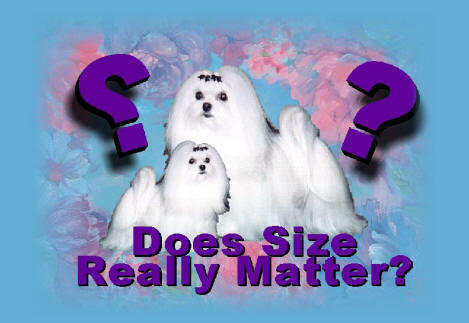|
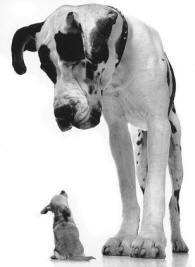 Does size really
matter? It definitely does if you are a Great Dane that is the size of
a Chihuahua, or
worse yet a Chihuahua the size of a Great Dane! It is important to
remember that each breed has certain characteristics, traits, and size
which make a dog a good representative of whatever breed it is supposed
to be. Does size really
matter? It definitely does if you are a Great Dane that is the size of
a Chihuahua, or
worse yet a Chihuahua the size of a Great Dane! It is important to
remember that each breed has certain characteristics, traits, and size
which make a dog a good representative of whatever breed it is supposed
to be.
So does the size
of your Maltese really matter? Of course it does! The American Kennel Club
standard for Maltese says 7 pounds and under with 4 pounds to 6 pounds
preferred. So where do the 10 - 15 pound supposedly purebred Maltese
come from?
As with all
physical characteristics size comes from genetics. Mother Nature truly
loves to play tricks on us sometimes, but sadly, chances are that many
of the larger Maltese are not purebred Maltese. It is a well known fact
that some disreputable breeders are actually mixing Maltese with such
breeds as Bichon Frise to produce larger litters, which in turn produces
more puppies and consequently more profit for the disreputable breeder. An average adult size for a
well bred Bichon Frise is 12 to 16 pounds. This likely is a huge reason
why there are so many larger, possibly curly/wavy haired, longer
muzzled “Maltese” out there.
In the past,
before DNA testing, it was very hard to prove or disprove the
parentage of the sire and the dam of a litter of puppies.
Therefore the disreputable breeder could use any combination of breeds
such as a Maltese and a Bichon Frise to register the litter as
purebred "whatever the breeder wanted" as long as the breeder had
registration papers for a sire and a dam of whatever breed the breeder
wanted to register. No one could prove otherwise. The true
parentage of a litter of puppies is still very hard to prove in untested
dogs. The AKC DNA program was implemented to ensure the accuracy
of the AKC stud books, and it was also the cause of a mass exodus of
commercial breeders from the AKC Registry who in turn started
registering their puppies in one or more of the many new registries that
seemed to pop up overnight. Simply put....they did not want to
prove the parentage of the dogs they were breeding as was required by
the newly implemented AKC DNA program.
A big red flag in the United
States is a dog that is registered with any other registry other than
the AKC.
The reason that
so many disreputable breeders chose the Bichon Frise to mix with Maltese
is easily apparent when comparing pictures of Maltese puppies to Bichon
Frise
puppies. Below are comparative pictures of a one day old Bichon
Frise puppy
litter compared to a one day old Maltese puppy litter……as you can see
there is a very minute difference in the appearance of the two litters.
What is noticeable at this point is the bit of wave in the Bichon Frise
puppies coats but not much else.
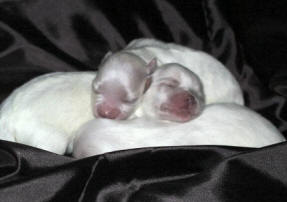
One day old
litter of
Foxstone Maltese puppies |
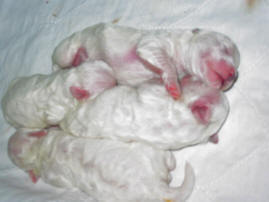
Photo of one day old Bichon Frise puppies,
courtesy of Mimi Winkler of
Judges Choice Bichons |
| |
|
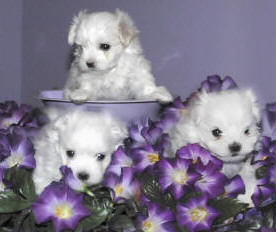
5 Week old Maltese Puppies |

5 week old Bichon Frise puppies
Picture courtesy of Webshots at
http://community.webshots.com/photo/163705820TDKnnI
|
At five weeks
old in the above pictures there still does not look to be a lot of
difference in the puppies other than in size.
By eight or nine
weeks old there should be some definite differences in size, overall
look, and coat texture.
An average sized
8 week old Maltese puppy is 2 pounds or less; an average sized 8 week
old Bishon Frise puppy
should weigh around 4 to 5 pounds.
Three of the
most obvious differences between a Bichon Frise and a Maltese after they
start getting older and into adulthood are a difference in coat texture,
a difference in size, and a difference in head structure. We have
already mentioned above that an adult Bishon Frise will weigh
between 12 and 16 pounds, whereas an adult Maltese should weigh around 7
pounds or under. There is a huge difference between 16 pounds and
7 pounds.
Let's now
compare the two coat textures which you cannot do without knowing what
each of the coat textures are supposed to be.
-
Bishon
Frise: Coat
The texture of the coat is of utmost importance. The undercoat is
soft and dense, the outercoat of a coarser and curlier texture. The
combination of the two gives a soft but substantial feel to the
touch which is similar to plush or velvet and when patted springs
back. When bathed and brushed, it stands off the body, creating an
overall powder puff appearance. A wiry coat is not desirable. A
limp, silky coat, a coat that lies down, or a lack of undercoat are
very serious faults.
Color
Color is white, may have shadings of buff, cream or apricot around
the ears or on the body. Any color in excess of 10% of the entire
coat of a mature specimen is a fault and should be penalized, but
color of the accepted shadings should not be faulted in puppies.
-
Maltese:
Coat and Color
The coat is single, that is, without undercoat. It hangs long, flat,
and silky over the sides of the body almost, if not quite, to the
ground. The long head-hair may be tied up in a topknot or it may be
left hanging. Any suggestion of kinkiness, curliness, or woolly
texture is objectionable. Color, pure white. Light tan or lemon on
the ears is permissible, but not desirable.
As you can see
from the above coat standards a Bichon will have a curly coarser feel to
the outer coat and a soft dense undercoat, whereas a Maltese is supposed
to have a silky coat that hangs next to the body with no undercoat
whatsoever. This particular aspect of the difference in coat
texture is sometimes a little hard to see in young puppies but a
knowledgeable eye will be able to see the difference. Even in a
puppy coat, a Maltese puppy should not have coarse, curly, or
excessively wavy hair. There should be a "shine" to it that is
lacking on a cotton coat or incorrect coat texture. A correct
silky coat on an adult Maltese will feel cool to the touch.
The proper head
structure of a Bichon Frise is three parts muzzle to five parts skull.
This type of muzzle is gorgeous on a correct Bichon Frise but it is
definitely way to much muzzle and is incorrect for a Maltese and does
not give the desired expression that is so much a part of the Maltese
breed.
So if you are
looking for and/or paying for a Maltese, then, in fact, you should get a
Maltese that is as close to the breed
standard as possible. As I said earlier, mother nature can (and
does) play tricks on even the most dedicated and reputable breeders every now and
then, which can result in a larger than normal Maltese or conversely,
Maltese that are under the 4 pound preferred weigh.
Irregardless,
it should still look like a Maltese with all of the standard Maltese
traits. A reputable breeder is going to be honest with you about the
potential size that any puppy may end up being. They are not going to
tell you that a particular puppy is going to be tiny, teacup,
micro-mini, toy, or any other glitzy term and then you find out, after
you have grown attached to your puppy, that it is going to be over the 7 pound
standard or, heaven forbid, 10 to 15 pounds.
So.....Does size really matter when
looking for a purebred Maltese????
In most cases...........YES!!!!
|
